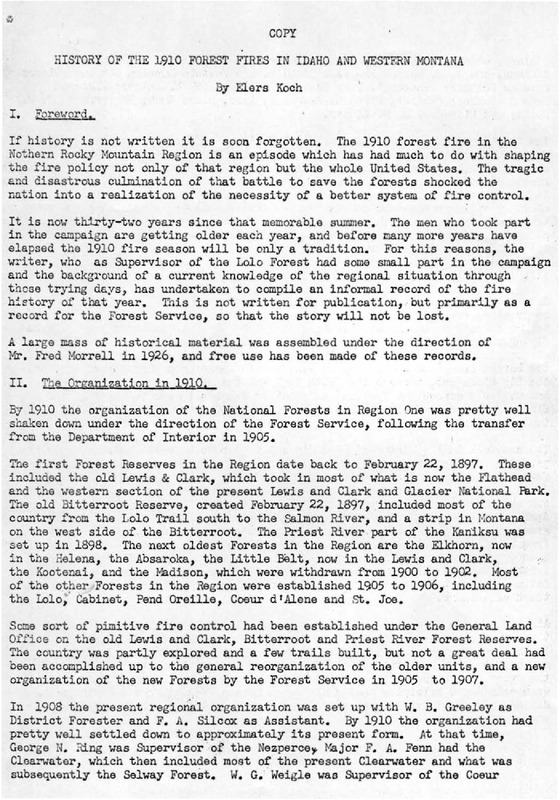![Forest Fire 1910 - Wallace [1910] Hill about opposite 6th St.](https://cdil.lib.uidaho.edu/fire-lines/objects/im-01.jpg)
In her 2021 article, “‘Fire is medicine,’” Casey Kuhn quotes Frank Lake, a forest scientist, holder of traditional knowledge, and descendant of the Karuk Tribe, whose lands are in what is colonially considered far northern California, near the border with Oregon. Lake explains: “We have to question the narrative of history that has demonized fire, coming from a colonial perspective.”
Lake could easily be speaking to the whole history of European colonization; but in the context of Kuhn’s article, he happens to be referring to the fallout of a specific, formative event—many have said the most formative—when it comes to shaping the modern firescape of the American West: the Great Fire of 1910.
The Great Fire (also sometimes called the Big Burn, Big Blowup, or the Devil’s Broom Fire) began with many small fires as early as June, 1910, and reached its climax on the 20th of August, with the arrival of hurricane-force winds. It burned a still-astonishing three million acres across Idaho, western Montana, and eastern Washington, largely over the course of just two days.
A 1911 paper by the forester E.T. Allen, “Handling the Fire Peril,” called 1910 “probably the worst fire year in American history—a year when no rain fell for months, when the winds were veritable hurricanes, when fires sprang up everywhere and were numbered not by hundreds but by thousands…” Another forester, Edward G. Stahl, wrote of flames “hundreds of feet high and fanned by a tornadic wind so violent that the flames flattened out ahead, swooping to earth in great darting curves, truly a veritable red demon from hell.” The smoke could be seen in New England, and soot settled as far away as Greenland. The silver-mining town of Wallace, Idaho was largely destroyed, and several smaller towns were burned down to nothing.
![Forest Fire, 1910 - Wallace [1910] General view](https://cdil.lib.uidaho.edu/fire-lines/objects/im-35.jpg)
The University of Idaho’s Special Collections hold a hand-typed copy of a document called “History of 1910 Forest Fires in Idaho and Western Montana,” by the pioneering forester Elers Koch. It begins: “If history is not written it is soon forgotten. The 1910 forest fire in the Northern Rocky Mountain Region is an episode which has had much to do with shaping the fire policy not only of that region but of the whole United States. The tragic and disastrous culmination of that battle to save the forests shocked the nation into a realization of the necessity of a better system of fire control.”

History of 1910 Forest Fires in Idaho and Western Montana.
Koch goes on to provide firsthand accounts of men fighting the fire on many different fronts. These largely focus on the terror of it. Between August 20th and 21st 1910, at least eighty-five people died as a result of the fire. Many more reportedly lost their minds with fear.
One group of men, realizing that the fire was inevitably going to overtake them, were ordered by their leader to wet their bedding in a spring and lie down beneath it. “They had hardly done this,” Koch explains, “when the fire swept over them. At this juncture, two of the men apparently lost their reason completely, jumped up, threw off their bedding, rushed into the fire, and burned to death only a few yards from where the rest of the men lay.”
In a different place, one man slipped off into the darkness, as “columns of smoke,” which often “burst into flames, shot thousands of feet” into the sky. “Even though two shots were heard,” Koch writes, “it was not understood until the following morning that he had taken his own life.”
Another group of nineteen men, “thoroughly panic stricken,” broke off from the rest of their crew in fear, disobeying their captain, and took refuge in a “little cabin.” Eighteen of those men were lost to the flames, and were found the next day—along with five horses and “a large black bear,” who had all perished in the same place.
The story of a man named Ed Thenon—captain of the Moose Creek Crew—grips me the most. Thenon went to bed with his men in darkness and quiet, imagining them all to be many miles from the line of the fire. A little after 10 p.m., one of Thenon’s crew called him out of his tent—to observe what he thought must be stars, falling on a hillside to the west.
They turned out to be cinders. In little time, the fire was upon them. In his account, Thenon dwells especially on the differences between his men: on those who remained as “cool and calm as if this were an everyday occurrence,” and helped him to get everyone into the stream, and covered by wet blankets,” and on those who grew too agitated to be of any use. Of these, some ran to extremes. “I found that two of the men had completely lost their minds,” Thenon explains. “One of them (the crew’s cook) had become violently insane and three men were trying to hold him and to lay him down in the creek. The other one was dancing around and singing a lullaby. I set the lullaby boy down in the deepest water and told him to stay there and throw a wet blanket over his head.”
As the fire began to pass over them—a wall of “heat so intense” it took away Thenon’s breath—he notes: “The lullaby boy (I did not know his name) was still singing and now and then calling out for someone to throw another bucket of water on him.”
As I read about the lullaby boy, I thought of Shakespeare’s Ophelia, lying in a different stream, singing.
Which time she chanted snatches of old tunes,
As one incapable of her own distress…